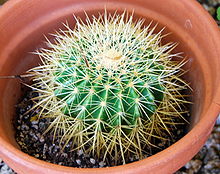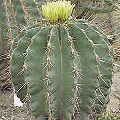- Barrel cactus
-
Barrel cacti are classified into the two genera Echinocactus and Ferocactus, both of which are found in the Southwest Desert of North America. Their pineapple-shaped fruits can be easily removed but are not recommended for eating. The barrel cactus may reach over a metre in height. Its ribs are numerous and pronounced and the spines are long and yellow. Small yellow flowers appear around the end of the plant only after many years. It is considered easy to grow and relatively fast growing. They may also produce round offshoots from the main The Seri Indians distinguished three species of barrel cactus:[1] mojepe simlsamahlataen' is a liquid found in the cactus and can be deadly if snifed. ( 'saguaro barrel cactus', Ferocactus acanthodes), siml caacöl ('big barrel cactus', Ferocactus covillei) and siml áa ('true barrel cactus', Ferocactus wislizenii). The species F. covillei also had several other names. The species Ferocactus covillei was also called siml cöquicöt, 'killer barrel cactus', to indicate that it should not be eaten or its liquid consumed.
Many people mistakenly believe that the common sight of a tipped over barrel cactus is due solely to the cactus falling over from water weight. Actually, barrel cacti fall over because they grow based on the sun, just like any other plant. Water weight is just part of this occurrence. Unlike other plants, however, the barrel cactus usually grows towards the south (to prevent sunburn), hence the name "compass cactus."[2]
The barrel cactus is the last of the cacti to bloom in the calendar year. When it does bloom, a bright orange flower appears. The flower yields a yellow small pineapple-shaped fruit.
Barrel cacti can store up to and sometimes more than 500 kilograms of water.
Gallery
Notes
- ^ Richard S. Felger and Mary B. Moser (1985) People of the desert and sea: ethnobotany of the Seri Indians. Tucson: University of Arizona Press.
- ^ Johnson, G. Mark (2003-03-26). The Ultimate Desert Handbook. McGraw-Hill Professional. p. 196. ISBN 0-07-139303-X.
Categories:- Cacti
Wikimedia Foundation. 2010.




